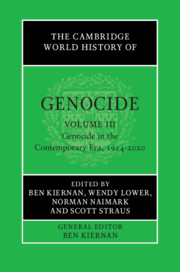Book contents
- The Cambridge World History of Genocide
- The Cambridge World History of Genocide
- The Cambridge World History of Genocide
- Copyright page
- Contents
- Figures
- Tables
- Maps
- Contributors to Volume III
- Introduction to Volume III
- Part I Racism, Total War, Imperial Collapse and Revolution
- Part II World War Two
- Part III The Nation-State System during the Cold War
- Part IV Globalisation and Genocide since the Cold War
- 26 Genocide in Bosnia and Herzegovina, 1992–1995
- 27 The Rwandan Genocide in Context
- 28 Genocides in the Sudans
- 29 Elements of Genocidal Ideology in Al-Qaeda and Its Offshoots, including Islamic State
- 30 The Yazidi Genocide
- 31 Genocide in Myanmar
- 32 A Short History of Genocide Prevention across the Long Twentieth Century
- Index
31 - Genocide in Myanmar
The Assault on the Rohingya, 2010–2019
from Part IV - Globalisation and Genocide since the Cold War
Published online by Cambridge University Press: 23 June 2023
- The Cambridge World History of Genocide
- The Cambridge World History of Genocide
- The Cambridge World History of Genocide
- Copyright page
- Contents
- Figures
- Tables
- Maps
- Contributors to Volume III
- Introduction to Volume III
- Part I Racism, Total War, Imperial Collapse and Revolution
- Part II World War Two
- Part III The Nation-State System during the Cold War
- Part IV Globalisation and Genocide since the Cold War
- 26 Genocide in Bosnia and Herzegovina, 1992–1995
- 27 The Rwandan Genocide in Context
- 28 Genocides in the Sudans
- 29 Elements of Genocidal Ideology in Al-Qaeda and Its Offshoots, including Islamic State
- 30 The Yazidi Genocide
- 31 Genocide in Myanmar
- 32 A Short History of Genocide Prevention across the Long Twentieth Century
- Index
Summary
Insofar as the wider world paid much attention to Myanmar,1 by 2010 it was to see it as another state emerging from a dictatorship to some form of democratic rule2. Faced by massive civil unrest in the aftermath of Cyclone Nargis,3 the military regime conceded a new constitution and elections to a parliament in 2010. Objecting to the restrictions imposed on its leader, Aung San Suu Kyi, the National League for Democracy (NLD) boycotted that round but did stand in the 2011 elections.4 Here they won the majority of the votes cast by the ethnic Burmese community (who make up some 70 per cent of the population of Myanmar), suggesting that even with the embedded role of the military5 (which the constitution set as the key guarantors of the state, reserving a number of seats in parliament for their own political party), the state was moving towards the status of a conventional democracy. That the leader of the NLD had spent most of the previous twenty years under house arrest and had won the Nobel Peace Prize in 1991 seemed further reassurance of Myanmar’s likely trajectory away from dictatorship and intercommunal conflict.6
- Type
- Chapter
- Information
- The Cambridge World History of Genocide , pp. 746 - 762Publisher: Cambridge University PressPrint publication year: 2023



